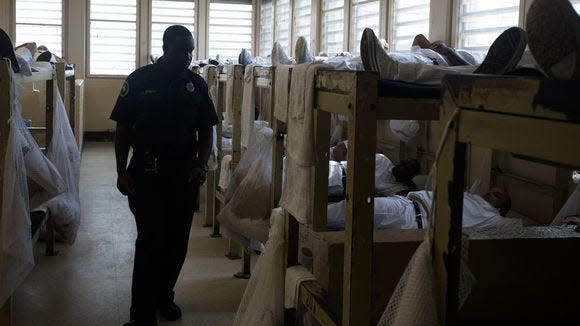Two more lawsuits filed to stop Alabama prison construction

Opponents of Alabama’s prison construction project filed two more lawsuits Monday aiming to block construction, arguing the project misuses federal funds and has moved forward without proper environmental studies.
The lawsuits, both filed in the U.S. Middle District Court of Alabama, are the latest broadsides against the $1.3 billion project, which would erect two 4,000-bed men’s prisons in Elmore and Escambia counties. Both suits target the state’s use of $400 million in American Recovery Plan Act (ARPA) funds to finance the construction of the prisons, and name state agencies and the U.S. Department of the Treasury as defendants.
“Alabama has fundamental issues around education, health care, the provision of health care, and sanitation,” said Eric Glass of Justice Capital, an investment fund that has organized opposition to the project. “That to me is far more aligned with the spirit and intention of federal relief.”
The Department of Finance said in a statement Tuesday that new prisons were "absolutely and undeniably necessary to support the safety of both inmates and staff, to improve mental health care, to provide space for vocational and rehabilitative programs, and ultimately to protect public safety."
"The state continues to move towards closing its bond issue to finance these facilities," the statement said. "No eleventh-hour lawsuits by inmates or activists will halt these efforts, and the state intends to move to dismiss the lawsuits and to vigorously defend against the claims as being without merit."
Messages seeking comment were sent to the Alabama Department of Corrections, the Alabama Department of Finance, and the U.S. Department of the Treasury.
The Legislature approved the project at the end of a special session last October after years of campaigning by Gov. Kay Ivey and the Department of Corrections. DOC had argued that current prison facilities were unsafe and lacked the space for rehabilitative programs. Supporters said the new prisons would need less staff and allow more programming.
For years, Alabama’s prisons have faced a torrent of violence. The U.S. Department of Justice sued the state in 2020, arguing the violence violated inmates’ Eighth Amendment protections against cruel and unusual punishment. Opponents said new construction would not address fundamental cultural and staffing issues in state prisons fueling the violence.
The plaintiffs in the lawsuits include inmates in the state’s prison system.
Bosarge et. al. v. the United States Department of Treasury argues that the state failed to provide proper notice and time for the public to comment on the Elmore County prison, and did not consider the environmental impact of the prison, in violation of the federal National Environmental Policy Act (NEPA). The suit argues that because the prisons use federal money, the construction of the facilities should be subject to NEPA.
“Defendants … have been engaged in construction-related activities and have appropriate funds for the construction (of prisons),” the lawsuit says. “Defendant Treasury has failed to enforce compliance with NEPA.”
The second, Kincaid et. al. v. U.S. Department of the Treasury et. al., argues that the Department of the Treasury should enforce its final rule on the use of ARPA money, saying that “construction of new correctional facilities as a response to an increase in the rate of crime” is “generally ineligible” for ARPA fund use.
“In Alabama’s case, the state explicitly knew that the Treasury was set to weigh in on proper use of the funds, as they submitted a letter requesting clarification about whether prisons could be financed with ARP financing,” the lawsuit says. “Rather than waiting for a response, Alabama moved forward with its prison plan, circumventing the authority of the Treasury to determine the proper use of congressionally appropriated funds.”
While the final rule discourages the use of ARPA money for prisons, the Department of the Treasury in January released compliance language that said it would “generally not take action to enforce provisions contained in the final rule” if a government had started spending money under earlier, broader rules for spending ARPA funds.
Troy Connell, an inmate at St. Clair Correctional Facility, sued to block the project last month, arguing the state had an obligation to first improve prison staffing, as required by a federal court order.
More: Alabama inmate sues to block funding for prison construction
'Our job certainly is not done': Bond sale for prison construction comes in $200M short
The state planned to sell $725 million in bonds to finance the project, but the sale only brought about $509 million. The bond sale closed on Tuesday morning, according to the Department of Finance.
Bill Poole, the State Finance Director, said earlier this month that officials would look for other sources of revenue, but that the project would continue on schedule. The state hopes to have the prisons operational by 2026.
Contact Montgomery Advertiser reporter Brian Lyman at 334-240-0185 or blyman@gannett.com.
This article originally appeared on Montgomery Advertiser: Two more lawsuits filed to stop Alabama prison construction
